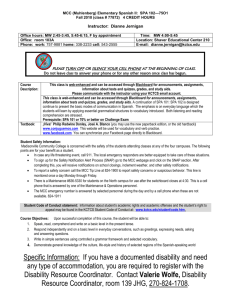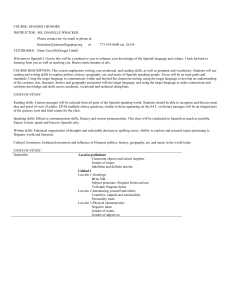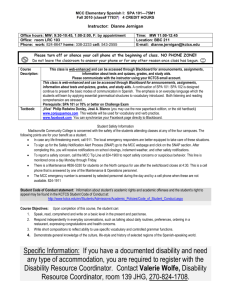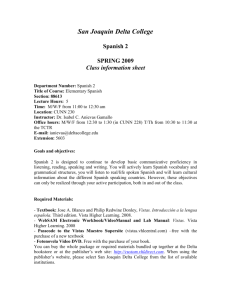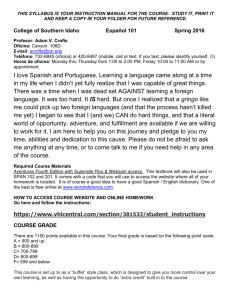Course: Acc. Spanish III School
advertisement
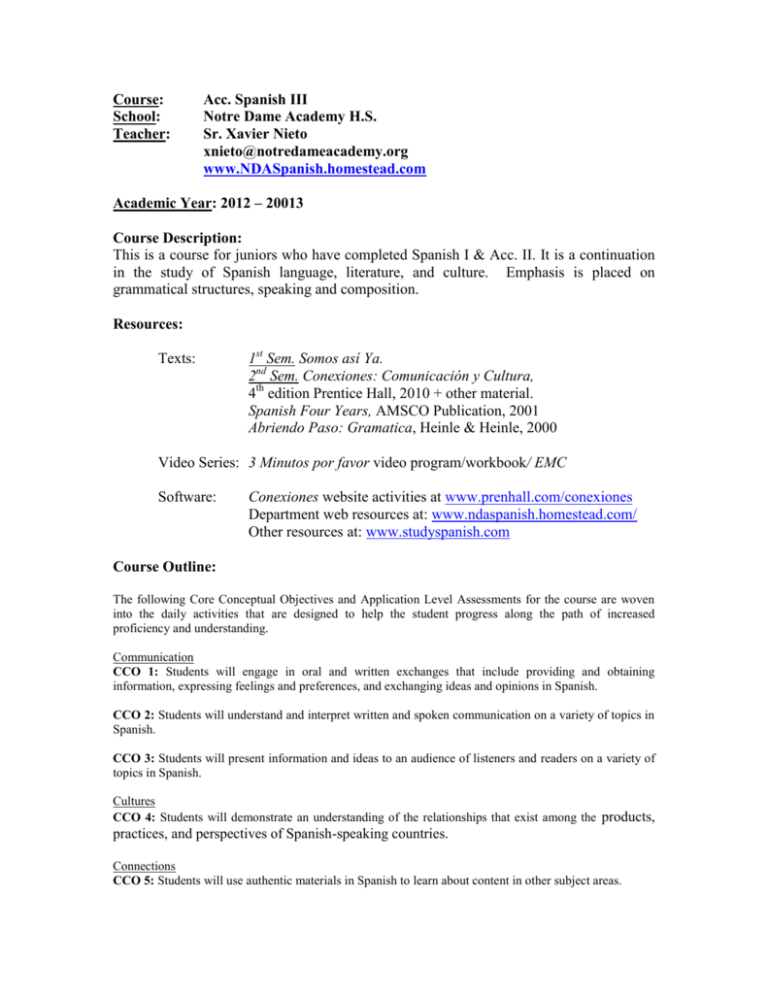
Course: School: Teacher: Acc. Spanish III Notre Dame Academy H.S. Sr. Xavier Nieto xnieto@notredameacademy.org www.NDASpanish.homestead.com Academic Year: 2012 – 20013 Course Description: This is a course for juniors who have completed Spanish I & Acc. II. It is a continuation in the study of Spanish language, literature, and culture. Emphasis is placed on grammatical structures, speaking and composition. Resources: Texts: 1st Sem. Somos así Ya. 2nd Sem. Conexiones: Comunicación y Cultura, 4th edition Prentice Hall, 2010 + other material. Spanish Four Years, AMSCO Publication, 2001 Abriendo Paso: Gramatica, Heinle & Heinle, 2000 Video Series: 3 Minutos por favor video program/workbook/ EMC Software: Conexiones website activities at www.prenhall.com/conexiones Department web resources at: www.ndaspanish.homestead.com/ Other resources at: www.studyspanish.com Course Outline: The following Core Conceptual Objectives and Application Level Assessments for the course are woven into the daily activities that are designed to help the student progress along the path of increased proficiency and understanding. Communication CCO 1: Students will engage in oral and written exchanges that include providing and obtaining information, expressing feelings and preferences, and exchanging ideas and opinions in Spanish. CCO 2: Students will understand and interpret written and spoken communication on a variety of topics in Spanish. CCO 3: Students will present information and ideas to an audience of listeners and readers on a variety of topics in Spanish. Cultures CCO 4: Students will demonstrate an understanding of the relationships that exist among the products, practices, and perspectives of Spanish-speaking countries. Connections CCO 5: Students will use authentic materials in Spanish to learn about content in other subject areas. Comparisons CCO 6: Students will develop insights about their language and culture through the study of the Hispanic language and culture. Communities CCO 7: Students will use Spanish both within and beyond the school setting. Schedule of course content: Semester 1: MP1 Capítulo 4 Capítulo 5 MP2 Capítulo 5 Capítulo 6 Las Noticias Lección 13 Premio en el periódico Lección 14 Periodista por un día Lección 15 Resumen de noticias Lección 16 ¿Qué había pasado? La ciudad Lección 17 ¡Cuidado con ese coche! Lección 18 Pero, ¿dónde estamos? La ciudad (continuación) Lección 19 De visita en Nueva York Lección 20 Una invitación por correo Vamos de viaje Lección 21 Planes de viaje Lección 22 Tormenta en el aeropuerto Lección 23 En el albergue juvenil Lección 24 Ahí viene el tren Review Semester & Midterm exam (January 2013) Semester 2: MP 3 Capítulo 1: Esas modas que van y vienen Objetivos comunicativos • Discussing fashion trends and fads • Saying what occurred in the past • Describing in the past • Talking about the influence of fashion on cars • Narrating in the past Capítulo 2: La tecnología y el progreso Objetivos comunicativos • Discussing environmental issues affecting your world • Describing people, places, and things • Describing what will or might be • Predicting future issues • Expressing hopes and desires * Plus other material MP 4 Capítulo 3: Los derechos humanos Objetivos comunicativos • Discussing human rights and foreign policy • Reacting to issues • Willing others to act • Discussing the work of charitable organizations • Describing what is done for you and others • Expressing likes and opinions Capítulo 4: El individuo y la personalidad Objetivos comunicativos • Talking about yourself and others: personality and routines • Discussing personality • Describing people, things, and situations • Talking about what has happened so far * Plus other material Review Semester & Final exam (May & June 2013) Teaching Methods: A variety of teaching methods will be used during class including: visual, auditory and kinesthetic input/practice, in-class practice in Spanish of the four skills of communication (listening, reading, writing, speaking), cooperative learning, individual assistance, whole group instruction, incorporation of multi-media (video/computer activities), differentiation and acceleration. Course Evaluation Criteria: Conexiones Textbook Homework exercises—No partial or late credit is given. All work must be 100% completed by the specified time, usually the next day. Textbook exercises in class activities. Participation points awarded for completion. If absent these activities do not have to be made up, but are available for make up if the student desires. There are many opportunities for earning participation points in class and these can easily be made up in other ways. Quizzes—several per chapter Dialogues, interviews, role-plays or narratives for in-class practice and for proficiency evaluation Chapter projects—may include essays, web quests, presentations, etc. Global Comprehension Assessment—one for each unit Abriendo Paso Textbook Practice exercises from this text are usually assigned for individual student practice on an as needed basis. Students will be awarded points based on difficulty level of the different exercises. At the end of the quarter these points will be averaged just as class participation points are below. Quizzes on grammar topics--as needed. Video Series Episode worksheets & manual—filled out during the viewing and taken for a grade at the end of the viewing. Workbook pages-participation points awarded. Students are given these the day before viewing to help prepare them for it. They should be turned in the day after viewing. Participation Points Class participation is very important in the Spanish class. Everything we do in class means participation. Speaking participation-based on the following 5-point scale. Students are periodically evaluated at random using a variety of methods and an average is taken at the end of the quarter. 5 = quality Spanish, no English, speaks with ease 4 = good Spanish, no English, speaks with some ease 3 = OK Spanish, no English, speaks haltingly but tries 2 = mostly Spanish, a few English words 1 = trying to speak Spanish but has too much English interference 0 = nonsense Spanish or no Spanish Foreign Language Department Policies: Quarter Grade Calculation: Grades are based on the following approximate breakdown occurs by the end of the quarter. Quizzes =20% Tests & Projects = 60% Homework = 10% Class participation = 10% 5% speaking Spanish in class 5% behavior Classroom Rules: 1. Be on time. Be in your seat at the sound of the bell and do not leave it unless given permission. 2. Raise your hand to get the teacher’s attention. Do not call out. You may need to exercise a little patience. 3. Follow all directions promptly and accurately. Listen carefully. 4. Be prepared to learn. Sharpen pencils before class. Bring all necessary materials to class. Do not bring distracting items to class (food, toys, make-up, artwork, work from other classes, etc.). Show a positive attitude. 5. Be courteous. Think about how you would like to be treated by others. Use polite expressions (please, thank you, excuse me, I’m sorry). Consequences: 1. Verbal Warning 2. Conference with teacher 3. Detention or parents called 4. Detention and parents called 5. Office/Counselor referral When you are absent: 1. See teacher or fellow classmate to find out what you missed. Or you can email Sr. Nieto at xnieto@notredameacademy.org during your absence to get your daily assignments. Always try to verify this information with a second source in case something is forgotten in the transfer. 2. Show teacher completed homework due during absence. This must be accomplished within the time frame established in the student handbook. 3. Pick up handouts and corrected papers that were handed back in your absence from the teacher. 4. Turn in any work collected in your absence to the teacher. 5. Make-up any quizzes or tests taken in your absence. Quizzes, tests and in-class essays must be made up after school. Schedule this as soon as possible after you return to school.







